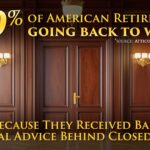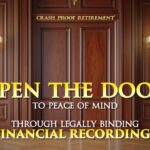Past performance is not a guarantee of future results. This statement, often echoed by brokers in the securities industry, underscores a common tautology — you either make money or you lose money. In simpler terms, this is how Wall Street deflects the risk of investing in assets that are tantamount to spinning a roulette wheel, or betting on a horse race. For younger Americans, this long-term gamble has a higher probability of succeeding, despite dealing with significant losses along the way. Eventually, however, the accumulation phase of an investor’s working career ends, and the investor no longer has ample recovery time when the market crashes.
The problem that investors encounter while transitioning from the accumulation phase to the retirement phase is the threat of the unknown. Predicting the future path of the stock market is one of the biggest unknowns in the financial industry, yet financial experts conjure forecasts and spread misinformation to keep investors blinded by the lust and vanity of risk investments. As a result, brokers are woefully ill-equipped to manage the transition into the retirement phase. When the market experiences a sharp decline, as it has in 2022, retirees who are stuck with Wall Street advisors find themselves in a helpless situation as their nest eggs erode without any education on how to prevent their nest eggs from experiencing losses in the first place. This phenomenon, known as the lost grow back time, exemplifies how investors accumulated wealth, gave it back during a market crash, and then had to spend time — years in most cases — trying to earn back what was lost. This period of gain and loss represents years of stagnation in investors’ portfolios.
To address this phenomenon, retirement phase experts utilize an economic theory known as the Look Back Principle to visibly explain how the stock market historically submerged accumulation phase investors in volatility. Investors who had their money in the S&P 500 from 2000 to 2002 would have lost nearly 50% or more of their portfolio on Wall Street and would have waited several years to regain most of what they lost (if they were lucky) before their accounts were slashed in half again during the 2008 crash. Although the index fully recovered by 2013 (14 years in total), many investors were never able to regain what they lost, for several reasons including: hidden charges and fees charged by their securities advisors that further eroded their accounts and trying to foolishly time the market.
Investors who are in the retirement phase of their lives are in a comparable situation today. After experiencing the 2020 market crash and recovery, investors are now watching the stock market meltdown at glacier speed. As of May 20th, the stock market had collectively lost over 20% while battling volatility for several months. Factors such as high inflation — reaching 8.3% in May — supply chain delays resulting from shutdowns in China, global conflicts, and Federal Reserve interest rate hikes, have all contributed to the stock market’s steady decline. The unknowns of present time question whether the market will find a bottom, while so-called experts encourage at-risk investors to buy the dip and try to discredit those who are sounding the alarm about the threat of a debilitating financial recession.
During this time of financial uncertainty, investors in or near the retirement phase of their lives need financial guidance that prioritizes safety and security. Any advisor that cannot accomplish this simple goal is more interested in earning a paycheck from investor fees, which are paid in full regardless of whether their client earns an unrealized return. Unfortunately, many investors are unaware of safe alternatives that guarantee principal protection of an investment. This is due to brokers and investment advisors purposefully pointing their investors in the opposite direction, saying that safe financial instruments are a fraud.
In lieu of investing in vehicles that could protect an investor’s nest egg, securities advisors encourage their clients to have a backup plan in the event that the stock market experiences a correction or crash. Even the media promotes this financially incompetent point-of-view, suggesting that retirees could transition to part-time employment, downsize from the home they’ve cultivated over the years and relocate, or simply reduce their living expenses. All of these suggestions dismiss the effect that inflation has in diminishing purchasing power.
Although brokers and the mainstream media propagate misleading information, leaders in Davos, Switzerland were singing a different tune at the World Economic Forum. International Monetary Fund Director Kristalina Georgieva said that the global economy faces the “biggest test since the Second World War,” which serves as a significant warning for investors in at-risk assets given the amount of social, political, and economic instability just in the United States alone. Instead of waiting for these cataclysmic events to occur, investors should be prudent with their hard-earned nest eggs and learn about vehicles that can protect their money without having to worry about the stock market’s risk and fees. When analyzing the known, unknown, and yet to be discovered portions of the financial industry, Americans in or near retirement should err on the side of caution and eliminate unnecessary risk from their portfolios by meeting with a licensed retirement phase expert. Retirees are often led to believe that they must keep their assets tethered to the stock market in order to grow their nest egg, but this is simply false. With a growing number of Americans (56% according to the National Institute of Retirement Security) concerned that they will outlive their savings, the inherent risk of the stock market is counterintuitive to the established goal of security and peace of mind in retirement.













